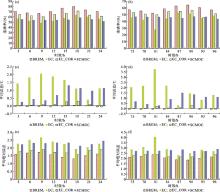国际刊号:ISSN 1673-503X
国内刊号:CN 21-1531/P

Journal of Meteorology and Environment ›› 2022, Vol. 38 ›› Issue (3): 119-126.doi: 10.3969/j.issn.1673-503X.2022.03.014
Previous Articles Next Articles
Duo QI( ),Song-tao LIU*(
),Song-tao LIU*( ),Guang-na ZHAO,Meng-zhu GAO
),Guang-na ZHAO,Meng-zhu GAO
Received:2021-07-22
Online:2022-06-28
Published:2022-07-23
Contact:
Song-tao LIU
E-mail:qiduoqiduo@126.com;jubird@sina.com
CLC Number:
Duo QI, Song-tao LIU, Guang-na ZHAO, Meng-zhu GAO. Predictive temperature deviation correction in winter half year based on multimodal integration[J]. Journal of Meteorology and Environment, 2022, 38(3): 119-126.

Fig.2
The predictive 2 ℃ accuracies in 2 m temperature of per 3 h in 3-24 h (a) and 75-96 h (b) forecast step, the 2 ℃ mean errors in 2 m temperature of per 3 h in 3-24 h (c) and 75-96 h (d) forecast step and the 2 ℃ mean absolute errors in 2 m temperature of per 3 h in 3-24 h (e) and 75-96 h (f) forecast step"

| 1 | 吴启树, 韩美, 郭弘, 等. MOS温度预报中最优训练期方案[J]. 应用气象学报, 2016, 27 (4): 426- 434. |
| 2 | 李佰平, 智协飞. ECMWF模式地面气温预报的四种误差订正方法的比较研究[J]. 气象, 2012, 38 (8): 897- 902. |
| 3 | 李莉, 李应林, 田华, 等. T213全球集合预报系统性误差订正研究[J]. 气象, 2011, 37 (1): 31- 38. |
| 4 | 马旭林, 时洋, 和杰, 等. 基于卡尔曼滤波递减平均算法的集合预报综合偏差订正[J]. 气象学报, 2015, 73 (5): 952- 964. |
| 5 | 王婧, 徐枝芳, 范广洲, 等. GRAPES_RAFS系统2m温度偏差订正方法研究[J]. 气象, 2015, 41 (6): 719- 726. |
| 6 |
Xu Z F , Wang Y , Fan G Z . A two-stage quality control method for 2-m temperature observations using Biweight means and a progressive EOF analysis[J]. Monthly Weather Review, 2013, 141 (2): 798- 808.
doi: 10.1175/MWR-D-11-00308.1 |
| 7 | 薛谌彬, 陈娴, 张瑛, 等. ECMWF高分辨率模式2m温度预报误差订正方法研究[J]. 气象, 2019, 45 (6): 831- 842. |
| 8 | 齐铎, 刘松涛, 张天华, 等. 基于格点的中国东北中北部2m温度数值预报检验及偏差订正[J]. 干旱气象, 2020, 38 (1): 81- 88. |
| 9 |
林春泽, 智协飞, 韩艳, 等. 基于TIGGE资料的地面气温多模式超级集合预报[J]. 应用气象学报, 2009, 20 (6): 706- 712.
doi: 10.3969/j.issn.1001-7313.2009.06.008 |
| 10 | 吴乃庚, 曾沁, 刘段灵, 等. 日极端气温的主客观预报能力评估及多模式集成网格释用[J]. 气象, 2017, 43 (5): 581- 590. |
| 11 | 智协飞, 黄闻. 基于卡尔曼滤波的中国区域气温和降水的多模式集成预报[J]. 大气科学学报, 2019, 42 (2): 197- 206. |
| 12 | 王焕毅, 谭政华, 杨萌, 等. 三种数值模式气温预报产品的检验及误差订正方法研究[J]. 气象与环境学报, 2018, 34 (1): 22- 29. |
| 13 | 吴春英, 刘多文, 钟博, 等. 基于数值预报模式的乡镇温度预报方法研究[J]. 气象与环境学报, 2019, 35 (1): 108- 112. |
| 14 | 智协飞, 伍清, 白永清, 等. 基于IPCC-AR4模式资料的地面气温超级集合预测[J]. 气象科学, 2010, 30 (5): 708- 714. |
| 15 | 张涛, 苗春生, 王新. LAPS与STMAS地面气温融合效果对比试验[J]. 高原气象, 2014, 33 (3): 743- 752. |
| 16 | 沈润平, 郭倩, 陈萍萍, 等. 高分辨率大气强迫和植被功能型数据对青藏高原土壤温度模拟影响[J]. 高原气象, 2019, 38 (6): 1129- 1139. |
| 17 | 曾晓青, 薛峰, 赵瑞霞, 等. 几种格点化温度滚动订正预报方案对比研究[J]. 气象, 2019, 45 (7): 1009- 1018. |
| 18 | 齐铎, 张天华, 王承伟, 等. 东北夏季天气分型及EC降水预报空间检验[J]. 气象与环境学报, 2020, 36 (3): 17- 25. |
| [1] | Hui-meng BAO,Da-feng GUO,Wei LI. Correction tests of ECMWF modeling quantitative precipitation using frequency matching method in Jiangxi provice [J]. Journal of Meteorology and Environment, 2022, 38(2): 12-20. |
| [2] | Yan-jing NIU, Xiang-jun XU, Huan GUO, Ming-ye LI. Verification of the short-term forecast of near-surface temperature using different global forecast products in China [J]. Journal of Meteorology and Environment, 2020, 36(4): 18-27. |
| [3] | ZHANG Dong-feng, WANG Yong-guang, ZHANG Guo-hong. Impact of sea surface temperatures in Western Pacific warm pool on precipitation in Shanxi province in mid-summer season [J]. Journal of Meteorology and Environment, 2019, 35(3): 60-67. |
| [4] | TIAN Hua, ZHANG Nan, ZHANG Kai-yi, YANG Jing, ZHANG Hui-chen. Advance on highway traffic meteorological research in foreign country [J]. Journal of Meteorology and Environment, 2019, 35(3): 79-86. |
| [5] | LIU Dan-ni, WU Yang, WANG Ying. Study on features of road-surface temperature on Zhoushan Bridge over the sea and its statistic model in summer [J]. Journal of Meteorology and Environment, 2018, 34(5): 86-92. |
| [6] | ZHAO Zi-qi, LI Li-guang, WANG Hong-bo, ZHAO Xian-li, JIANG Peng, WEN Ri-hong, DING Kang-kang, ZHAO Hu-jia, ZHAO Miao. Study on the relationships between land use and land surface temperature in Shenyang urban districts [J]. Journal of Meteorology and Environment, 2016, 32(6): 102-108. |
| [7] | LI Jin, CHEN Lian. Analysis of weather process of rain to snow in Hangzhou region in 2014 [J]. Journal of Meteorology and Environment, 2016, 32(5): 1-9. |
| [8] | LI Jia-qi, ZHANG Yu-kun, LI Yan, LUAN Jian, ZHOU Xiao-dong. Establishment and characteristic analysis of spatial variation pattern of thermal spectrum fingerprint [J]. Journal of Meteorology and Environment, 2016, 32(5): 92-98. |
| [9] | SHEN Hong-yan, MA Ming-liang, SHI Xing-he, DAI Sheng, MA Zhan-liang. Analysis of spring temperature anomaly and its impact factors in Qinghai plateau [J]. Journal of Meteorology and Environment, 2016, 32(1): 95-102. |
| [10] | LIU Dong-wei AO Xiang-yu TAN Jian-guo CUI Lin-li. Refined simulation of urban surface temperature distribution in Shanghai [J]. Journal of Meteorology and Environment, 2015, 31(2): 59-68. |
| [11] | ZHANG Fu-rong, ZHANG Guo-lin,FENG Xue-fei,LIU Zhi-peng, ZHANG Yu-Shu. Influence of climate warming on temperature at the surface and plow layer in the west region of Liaoning province [J]. Journal of Meteorology and Environment, 2014, 30(3): 96-99. |
| [12] | CUI Yan,LI Qian,ZHOU Xiao-yu,ZHANG Xiao-yue,ZHAO Chun-yu. Simulation and projection of the surface temperature based on five global climate models over the northeast China [J]. Journal of Meteorology and Environment, 2013, 29(4): 37-46. |
| [13] | HAN Jun-cai,ZHOU Shun-wu,LIU Wei. Characteristics of water vapor content and its influencing factors in summer over Northern China [J]. Journal of Meteorology and Environment, 2012, 28(6): 32-37. |
| [14] | SHEN Yu-min,HU Chun-li,LI Fei,WANG Xiao-tao,LI Ji1 LIN Rong,WEI Wei. Circulation background of spring soaking rain and its correlation with sea surface temperature in Liaoning province [J]. Journal of Meteorology and Environment, 2012, 28(4): 28-32. |
| [15] | JIANG Peng JI Rui-peng,FENG Rui,WU Jin-wen,YU Wen-ying,WANG Hong-bo,ZHAO Zi-qi,ZHANG Yu-shu. Retrieval of land surface temperature and its spatial distribution in Liaoning province based on multi-source remote sensing data [J]. Journal of Meteorology and Environment, 2012, 28(3): 44-48. |
| Viewed | ||||||
|
Full text |
|
|||||
|
Abstract |
|
|||||
|